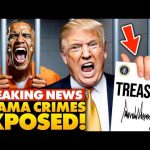In a bold and fiery statement recently broadcasted, former President Donald Trump grabbed headlines by accusing his predecessor, Barack Obama, of orchestrating a nefarious scheme to influence the 2016 election results. Trump’s words were charged, direct, and characteristic of his unyielding rhetoric. He claimed the former president was the mastermind behind an effort that he labeled as treasonous, expressing that such actions were beyond anything witnessed even in the most politically unstable countries.
Trump’s narrative suggests a clear and targeted attempt by Obama and select individuals to manipulate the electoral process, thereby undermining the democratic foundations of the nation. It’s crucial to reflect on the clarity with which Trump presented his argument, pointing not to a vague collection of shadowy figures, but directly naming Obama as the leader of this so-called “gang.” The accusation is not minor—calling it treason is one of the strongest assertions one can make about a public figure, especially a former president.
The former president’s remarks imply a vast conspiracy, suggesting that the plotting was not merely limited to the year 2016. This underscores a narrative of vigilantism, where those involved in the alleged plot operated under a shield provided by a sympathetic press, shielding Obama from the scrutiny he might otherwise face. Trump insisted that documents—and more are supposedly forthcoming—will substantiate these serious allegations.
Furthermore, these revelations tap into a larger discourse on media bias and accountability, resonating strongly with those who feel traditional media outlets have failed to hold the previous administration accountable. The exoneration and absolution granted to certain political figures can be perceived as one-sided, prompting calls for transparency and justice from those who believe the truth has long been suppressed in favor of a preferred narrative.
Americans are thus confronted with a pivotal moment: they can either demand an unrelenting pursuit for truth and consequences or succumb to a numb acceptance of partiality in media and justice. As these documents make their way into the public sphere, the ensuing discourse may deepen existing divides or illuminate paths toward reconciliation. The nation awaits tangible evidence and decisive action, hoping for clarity amidst the chaos of accusations and counterclaims that continue to trouble the political landscape.




